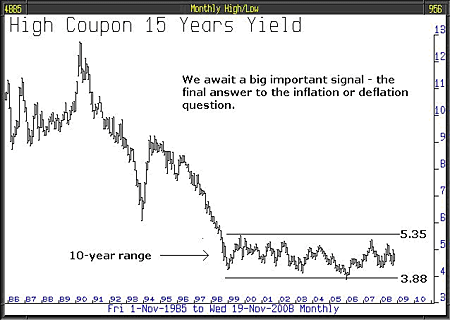
As we pointed out a long time ago, interest rates are going to historic lows as central banks everywhere try to stave off the depression and stem the deflationary force.
The credit markets have by no means normalised, they were not helped by America’s Treasury Secretary, Hank Paulson. Having fought to get TARP legislation through so that the US Treasury could purchase toxic assets held on banks’ balance sheets, he has now said that he is not going to do that, but instead use those funds to re-capitalise the banks. The reasons given are his concerns about other securitised lending, such as auto loans, student loans and credit card debt, which are also menacingly vulnerable to the economic conditions.
According to the Financial Times on 20 November, the National Association of Pension Funds (NAPF) have asked the government for more long-dated gilts. The article says that the group representing some of the UK’s biggest pension funds has written to the Chancellor urging him to issue more long-dated gilts to generate low risk investments for pension funds. Nobody reading this letter will be surprised to hear that because it is quite obvious to us that pension funds and investors generally, in economic conditions bordering on depression, will find that government bonds represent a safe and potentially very profitable haven. Clearly, those who are concerned about excessive issuance will be heartened to read that pension funds don’t think there’s going to be enough issuance to meet their needs.
Chris Hitchen, Chairman of the NAPF, in his letter to Alistair Darling, said that they believed that there is clear evidence that more issuance can be absorbed at the long end. UK pension funds, he said, were savaged in recent months by steep falls in equities and other asset classes such as property, hedge funds and commodities. He also added that they favoured index-linked gilts.
Every now and again a chart comes along that has above average predictive qualities. It is particularly the case when a trading range has been in situ for a long period of time. Such a chart is the 15-year gilt yield which has been in a trading range between 3.88% and 5.35% for an unbelievable ten years.
The reason such charts are predictive, is that very long term trading ranges, and this is a very, very long one, eventually end and the subsequent direction on ending is predictive of a very big move in that direction. If the chart breaks to the downside we expect gilt yields to fall to as low as 2.5%. This would generate huge gains for anybody holding long-dated gilts. If the trend breaks to the upside, inflation is coming back at 100 mph and the last investments in the world you would wish to hold are gilts.
We are quietly confident that the gilt holdings in the model portfolio, over the next year or so, will pay off handsomely.
• By John Robson & Andrew Selsby at Full Circle Asset Management, as published in the threesixty Newsletter.